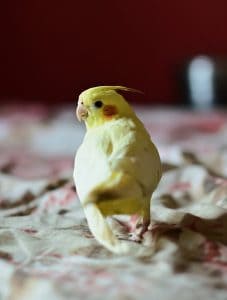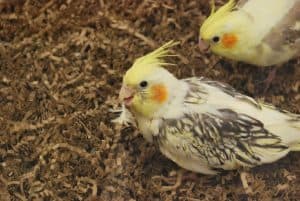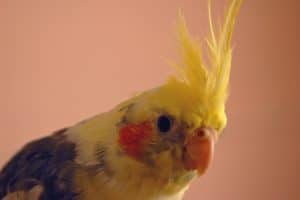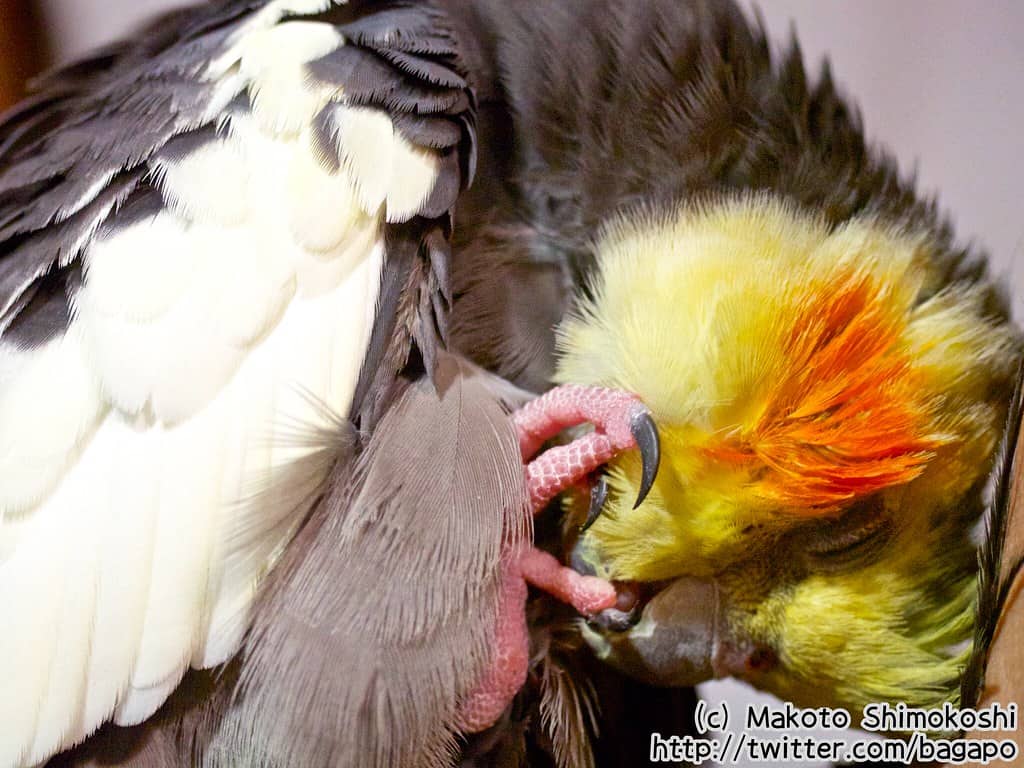When you bring a cockatiel into your home, you become responsible for its well-being. Understanding how to tell if a cockatiel is in pain can make a significant difference in its quality of life. Birds often hide their discomfort, making it crucial for you to recognize subtle signs.
You might notice changes in behavior, vocalizations, or physical appearance that indicate something’s wrong. By learning these signs, you can act swiftly to ensure your feathered friend gets the care it needs. Let’s explore the key indicators to help you keep your cockatiel happy and healthy.
Understanding Cockatiel Pain

Recognizing pain in cockatiels involves observing changes in their behavior and physical condition. Birds tend to hide signs of discomfort, so you must monitor your cockatiel for subtle signs. Look for changes in their energy levels, eating habits, and physical movements. Tail bobbing, frequent blinking, and feathers fluffed can indicate a problem.
Altered behaviors such as hiding for long periods or ignoring sounds may suggest your feathered friend is unwell. Physical symptoms like diarrhea, weight loss, and a raised foot can be signs of pain. Cockatiels drink less and may have liquid urine when in pain. Additionally, frequent tail bobbing, particularly when your cockatiel is at rest, is a significant indicator.
Consulting an avian vet for a physical examination is essential if you notice any of these symptoms. An avian vet may recommend fecal tests or fungal testing to identify underlying issues. Ensuring a healthy vent and monitoring for other signs like seizures is crucial. For comprehensive care, listen carefully to your vet’s advice and follow any prescribed treatment plans for your cockatiel.
Common Signs of Pain in Cockatiels
Recognizing when a cockatiel is in pain can be challenging due to their natural behavior to hide discomfort. Awareness of particular signs helps ensure your feathered friend remains healthy and happy.
Changes in Appetite
If your cockatiel’s eating habits change, it might indicate pain. Refusal to eat or reduced food intake are concerning signs. Monitor their eating habits and note any significant weight loss. Cockatiels drink less water when in pain, increasing dehydration risks. Changes in eating habits warrant a prompt visit to an avian vet.
Respiratory Issues
Respiratory problems often signal discomfort in cockatiels. Tail bobbing, open-mouth breathing, or labored breathing are red flags. Listen carefully to their breathing—clicking or wheezing sounds could indicate severe issues. If your cockatiel exhibits these symptoms, consult an avian veterinarian immediately.
Altered Appearance
Physical changes can point to a cockatiel in pain. Look for feathers fluffed up for long periods or frequent blinking indicating discomfort. Notice other signs like a foot raised frequently or a sudden drop in grooming behavior. A thorough physical examination by your avian vet can identify underlying problems.
Behavioral Changes
Behavioral changes are among the most frequent signs of pain. Watch for hiding more than usual or ignoring sounds, as these can be subtle signs of discomfort. Your cockatiel might also display increased aggression or lethargy. Any significant behavioral shift, especially if combined with other signs, requires immediate veterinary attention.
Specific Behavioral Indicators

Cockatiels, like many pet birds, often hide their pain. Recognizing subtle signs is essential for ensuring their well-being.
Vocalization Variations
Changes in your cockatiel’s vocalizations can indicate discomfort. Listen carefully for differences in pitch, frequency, and volume. A cockatiel in pain may cry frequently or become unusually quiet. If your usually chatty bird suddenly stops vocalizing, it might be experiencing distress. Consult an avian vet if these vocal changes persist.
Feather Picking and Self-Mutilation
Feather picking and self-mutilation are serious indicators of pain. When a cockatiel starts plucking its feathers or injuring itself, it’s often a sign of severe discomfort or stress. Hiding signs behind fluffed feathers or frequent picking can signal both physical and psychological issues. If you observe these behaviors, a physical examination by an avian specialist is necessary, possibly including fungal testing or fecal tests to identify underlying problems.
Changes in Activity Levels
Altered activity levels can be subtle signs of pain in cockatiels. Active birds that suddenly become lethargic or spend long periods hiding may be in pain. Notice if your cockatiel is frequently blinking or has its feathers fluffed up. Additionally, if your bird shows signs such as tail bobbing or a foot raised often, these can indicate discomfort. Consult a qualified avian veterinarian if there is a sudden drop in energy or prolonged inactivity.
Monitoring these specific behavioral indicators helps ensure that your feathered friend remains healthy and happy.
- Enriching the Life of BirdsThis parakeet nesting box adopts combination of natural pine and high-quality transparent acrylic window. Not only makes it easy for us to clear see the state of parrots in the bird breeding box through the acrylic side, but also can observe and record the breeding and hatching process between parrots. In addition, we added a wooden board that is very easy to install and remove, so that the parrot can have a dark environment at night while sleeping.
- Safe and Durable Material Bird nesting box is respectively made of natural pine wood, acrylic window which are warm and cozy, safe, non-toxic, chewable and transparent field of view to ensure healthy breeding for parakeet birds. After you observe the activities of the parrot, if you feel that the bird box is too bright, you can install a small wooden board at any time, so that you will be at ease.
- Easy to use Each bird's nest box includes accessory screws and bird perches to fit completely inside or outside the cage. There is compartment inside the box to protect the bird eggs, and the hinged lid is designed for easy opening and closing of the bird nest box, as well as quick cleaning and changing of bird bedding materials.
- Good Parrot Supplies Pet bird owners have a common hobby, that is to keep looking for good quality pet supplies for their little animals. This parakeet nesting box is a practical house for breed, rest, sleep, relax and play. Its also a good gift for your lovely parrots.
Physical Symptoms to Watch For
Pain in a cockatiel may not always be immediately apparent. You need to observe their physical condition closely to detect subtle signs that your feathered friend is in discomfort.
Unusual Postures
You might notice unusual postures if your cockatiel is in pain. Tail bobbing can be one such posture, especially if coupled with labored breathing. Another indicator is when the bird consistently keeps one foot raised for long periods, which may signify foot pain. Look for frequent blinking or half-closed eyes, as these can also be signs of discomfort. Additionally, feathers fluffed up for extended periods often signal that the bird is unwell.
Visible Injuries or Swellings
Visible injuries and swellings are key symptoms of pain in cockatiels. Regularly check for any cuts, bruises, or swellings on your bird’s body. Swelling around the feet or joints may indicate an infection or other health issue. Inspect their droppings; deviations from healthy bird droppings consist, such as diarrhea seizures or liquid urine, can signify pain or illness. A quarantined cockatiel should undergo a thorough physical examination by an avian vet to rule out any serious conditions. Always consult your veterinarian if you notice these symptoms to ensure your bird’s well-being.
Steps to Take if You Suspect Pain

Addressing pain in your feathered friend promptly is vital to their well-being. There are several steps you can take to ensure your cockatiel receives the care it needs.
Consulting a Veterinarian
Visiting a qualified avian veterinarian is crucial if you notice any subtle signs of pain. Symptoms like diarrhea, seizures, tail bobbing, or frequent blinking indicate the need for a physical examination. The vet may perform tests such as fecal tests or fungal testing to identify any underlying issues. Always follow the veterinarian’s instructions closely, including administering the correct dose of any recommended pain medication.
Environmental Adjustments
Create a comfortable environment for a potentially sick bird. Place your quarantined cockatiel in a separate room to reduce stress from other birds. Ensure the room is warm and free from drafts, as feathers fluffed up in response to cold can mask symptoms. Pay attention to their diet; provide nutrient-rich food and clean, fresh water. Make sure to observe any changes in how your cockatiel drinks or eats, as these can be indicators of discomfort.
Keeping a Health Log
Maintaining a health log can help monitor your cockatiel’s condition. Note any behavioral and physical changes, such as a foot raised consistently, sudden hiding spells, or ignoring sounds. Record any deviations in droppings, including liquid urine or coiled brown feces. Track weight loss and other signs of illness over long periods to provide detailed information to your avian vet during consultations. This practice aids in early detection and treatment of common diseases.
Wrap Up: How to Tell If a Cockatiel Is in Pain
Recognizing the subtle signs of pain in your cockatiel is crucial for ensuring its well-being. By staying vigilant and observing any changes in behavior, vocalizations, and physical condition, you can take prompt action to address potential bird health issues. Always consult a qualified avian veterinarian if you suspect your cockatiel is in pain. Creating a comfortable environment and keeping a detailed health log can aid in early detection and treatment. Your proactive approach will help maintain your cockatiel’s happiness and health, ensuring it thrives as a cherished member of your family.
Key Takeaways: How to Tell If a Cockatiel Is in Pain
- Subtle signs first: birds hide pain—watch for decreased appetite, lethargy, hiding, or ignoring sounds.
- Physical red flags: persistent tail-bobbing, fluffed feathers, raised foot, labored breathing, frequent blinking, or visible injuries/swelling.
- Behavioral shifts: sudden quiet in a chatty bird, feather plucking/self-mutilation, or unexplained aggression.
- Check droppings: diarrhea, liquid urine, or color change can signal internal distress.
- Immediate action: isolate in a warm, quiet cage; schedule same-day avian vet visit; keep a health log of symptoms and weight changes.
- How Can Your Other Pets Be Harmful To Your Cockatiel
- How Cockatiels Show Affection
- How Do Children Make Cockatiels As Pets
- How Do Cockatiels See
- How Do Cockatiels Sleep
- How Do Fumes Affect Your Cockatiel
- How Do You Care For Your Cockatiel Everyday
- How Do You Choose A Cage For Your Cockatiel
- How Do You Medicate Cockatiels
- How Do You Provide Your Cockatiel With Water
- How Do You Select Your Cockatiel
- How Do You Tame A Cockatiel
- How Does A Cockatiel Got Her Name
- How Far Can A Cockatiel Fly
- How Far Can A Cockatiel See
- How Fast Can Cockatiels Fly
- How Good Is A Cockatiels Memory
- How Long Can A Cockatiel Go Without Food
- How Long Can Cockatiels Go Without Water
- How Long Do Cockatiels Actually Live For In Captivity
- How Long Do Cockatiels Live In Captivity
- How Long Does It Take For Clipped Wings To Grow Back
- How Long Does It Take For Cockatiel Tail Feathers To Grow Back
- How Long Should A Cockatiel Be Out Of Its Cage
- How Often Do Cockatiels Lay Eggs
- How Often Do Cockatiels Poop
- How Often Should A Cockatiel Go To The Vet
- How Should I Set Up My Cockatiels Cage
- How To Bathe Your Cockatiel
- How To Bird Proof A Room
- How To Bond Two Cockatiels
- How To Bond With A Scared Cockatiel
- How To Build Trust With A New Cockatiel
- How To Calm A Stressed Cockatiel
- How To Care For Your Cockatiels Health
- How To Care For Your Cockatiels Nails
- How To Catch A Cockatiel
- How To Clean Cockatiel Nose
- How To Clip A Cockatiels Nails
- How To Discipline A Cockatiel
- How To Find A Cockatiel That Flew Away
- How To Get A Cockatiel Back Into Its Cage
- How To Get A Cockatiel To Go On Your Hand
- How To Get A Cockatiel To Like You
- How To Get A Cockatiel To Sit On Your Finger
- How To Give Your Cockatiel Exercise
- How To Grow Millet For Cockatiels
- How To Hold A Cockatiel
- How To Introduce A New Cockatiel To Another
- How To Keep A Cockatiel Quiet
- How To Keep A Cockatiel Warm 10 Tips And Tricks
- How To Maintain A Clean Cockatiel Cage
- How To Make Your New Cockatiel Feel At Home
- How To Manage Multiple Cockatiels In One Household
- How To Monitor Your Cockatiels Health
- How To Prepare Your Cockatiel For Travel
- How To Prevent Your Cockatiel From Becoming Stressed
- How To Recognize And Treat Cockatiel Anxiety
- How To Take Care Of An Older Cockatiel
- How To Tame A Cockatiel That Bites
- How To Tame Your Cockatiel
- How To Teach A Cockatiel To Talk
- How To Tell If A Cockatiel Is In Pain
- How To Tell The Age Of A Cockatiel
- How To Toilet Train Your Cockatiel
- How To Train A Cockatiel To Fly To You 8 Steps
- How To Train A Cockatiel To Poop In One Place
- How To Train Naughty Cockatiels
- How To Transition Your Cockatiel To A New Cage
- How To Transport A Cockatiel To The Vet
- How To Trim A Cockatiels Beak
- How To Trim Your Cockatiels Wings




